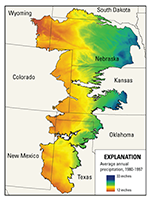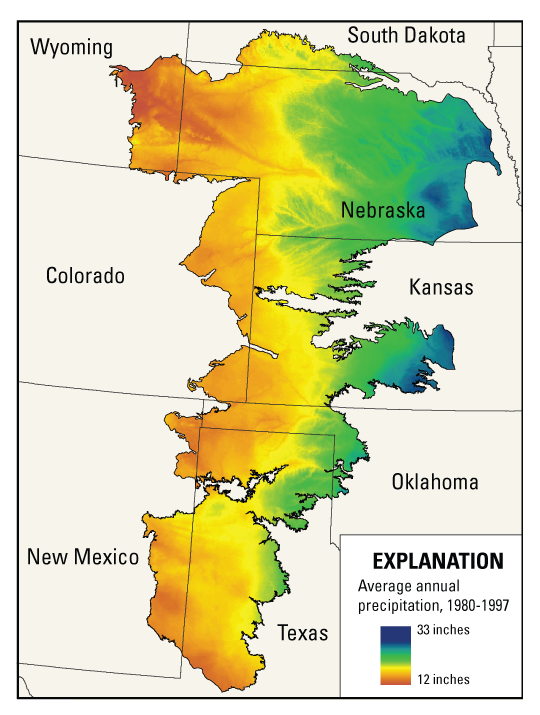USGS Nebraska Water Science Center
High Plains Water-Level Monitoring Study
High Plains Area
The High Plains aquifer underlies about 175,000 mi2 in parts of eight States:
- Colorado
- Kansas
- Nebraska
- New Mexico
- Oklahoma
- South Dakota
- Texas
- Wyoming
The area that overlies the aquifer occupies part of the Great Plains Physiographic Province. The Great Plains Physiographic Province is a vast east-tilted surface formed by deposition of sediment eroded from the ancestral Rocky Mountains, beginning about 65 million years ago. The Great Plains Physiographic Province is characterized by gently sloping, smooth plains. The land surface elevation of the High Plains area ranges from about 7,800 feet above the National Geodetic Vertical Datum of 1929 (NGVD 29) on the western boundary to 1,160 feet above NGVD 29 on the eastern boundary.

High-Plains Aquifer Characteristics
| Characteristic | Total | State | |||||||
|---|---|---|---|---|---|---|---|---|---|
| CO | KS | NE | NM | OK | SD | TX | WY | ||
| Area underlain by aquifer (mi2) | 174,050 | 14,900 | 30,500 | 63,650 | 9,450 | 7,350 | 4,750 | 35,450 | 8,000 |
| Percent of total aquifer area | 100 | 8.6 | 17.5 | 36.6 | 5.4 | 4.2 | 2.7 | 20.4 | 4.6 |
| Percent of each state underlain by aquifer | -- | 14 | 38 | 83 | 8 | 11 | 7 | 13 | 8 |
| Average area-weighted saturated thickness in 1980 (feet) | 190 | 79 | 101 | 342 | 51 | 130 | 207 | 110 | 182 |
| Volume of recoverable water in storage in 1980 (million acre-feet) | 3,250 | 120 | 320 | 2,130 | 50 | 110 | 60 | 390 | 70 |
Climate
During most years, in much of the area, irrigation is required for economic yields of typical crops—alfalfa, corn, cotton, sorghum, soybeans, peanuts, and wheat.
Middle-latitude dry continental climate:
abundant sunshine, moderate precipitation,
frequent winds, low humidity, high rate of evaporation
Mean annual temperature:
about 43 to 63°F (north to south)
Mean annual precipitation:
12 to 33 inches (west to east)
Population
Population in 1900:
0.9 million people
Population in 2000:
2.3 million people
Forty percent of the people live
in cities with a population greater than 20,000 (2000 census)
Water Development
Since the late 1880s, farming has been the dominant industry in the High Plains area and, in some of the area, farmers have irrigated using ground and surface water. For example, in the late 1800s, some farmers were irrigating crops using surface water diverted from the Platte and Arkansas Rivers and some were irrigating crops using shallow groundwater pumped to the surface by windmills. Through the early 1940s, depth to water in the aquifer and the slope of the land surface were major factors controlling the distribution of irrigated acres. By the early 1960s, technological advances in pumps allowed irrigation in areas with deeper (greater than 100 feet below land surface) groundwater, and the development of center-pivot irrigation systems in the 1970s allowed irrigation on rolling terrain. See USGS Professional Paper 1400B for further information on the history of water development in the High Plains area.
Land Use
Current land use:
55.6 percent rangeland
40.9 percent agricultural
3.5 percent a combination of wetlands, forest, urban, water, land barren lands
Agricultural Lands:
53 percent rowcrops (such as sorghum, corn, and cotton)
33 percent small grains (mostly wheat)
14 percent pasture, alfalfa, and fallow lands
Groundwater
Water table:
The upper boundary of the High Plains aquifer at predevelopment
Water Table Altitude:
Ranges from about 6,000 to 1,200 feet above NGVD 29.
Groundwater flow direction:
Generally from west to east and locally toward streams.
Average groundwater flow velocity:
About 1 foot per day (Gutentag and others, 1984).
Crops grown in the High Plains area are a substantial percentage of the total crop production for the United States. In 1997, crops grown in the High Plains area accounted for 19 percent of the wheat, 19 percent of the cotton, 15 percent of the corn, and 3 percent of the sorghum. In addition, the High Plains area accounts for about 18 percent of total cattle production and an increasing percent of total swine production in the United States (USDA Census of Agriculture).
Groundwater Use for Irrigation and Irrigated Acres
Estimated acreage irrigated with groundwater:
1949: 2.1 million acres
1980: 13.7 million acres
1997: 13.9 million acres
2002: 12.7 million acres
Proportion of Irrigated acreage in each state relative to total irrigated acres:
1980: 21 percent in Kansas; 38 percent in Nebraska;
2002: 15 percent in Kansas; 45 percent in Nebraska
Groundwater Withdrawals
Annual groundwater withdrawals from the High Plains aquifer for irrigation
From 1949 to 1974:
Increased from 4 to 19 million acre-feet
From 1980 to 2000:
Varied from 2 to 18 percent of 1974 withdrawals
In 2000:
By county, ranged from less than 0.01 million acre-ft to more than 0.25 million acre-ft
Depth to Groundwater
Depth to water:
Difference between the altitude of land surface and the altitude the water table.
Depth to water in 2000:
Ranges from land surface to more than 300 feet below land surface
Water-Level Changes from Predevelopment (about 1950) to 2015
Water-level changes:
A rise of 84 ft in Nebraska to a decline of 234 ft in Texas
Declines of 5 ft or more in about 36 percent of the aquifer area
Rises of 5 ft or more in about 8 percent of the aquifer area
Between a decline of 5 ft and a rise of 5 ft in about 57 percent of the aquifer area.
Number of wells used to calculate change:
3,164 wells
Generalized Geology and Hydrogeology
The geologic units that make up the High Plains aquifer and the underlying bedrock units range in age from Permian to Quaternary. The composition of the units that compose the High Plains aquifer includes
- poorly sorted clay, silt, sand, and gravel, generally unconsolidated, deposited by streams and wind (Ogallala Formation and Quaternary units)
- very fine to fine-grained sandstone (Arikaree Group)
- siltstone containing sandstone and interconnected fractures (upper part of the Brule Formation)
The composition of the bedrock units that underlie the High Plains aquifer includes
- siltstone
- shale
- loosely to moderately cemented clay and silt
- chalk
- limestone
- dolomite
- conglomerate
- claystone
- gypsum
- anhydrite
- bedded salt
Geologic Units
| Geologic unit comprising the aquifer |
System (series) and High Plains aquifer comprising millions of years before present |
Composition | Location where geologic unit is a substantial part of the High Plains aquifer | |||||||
|---|---|---|---|---|---|---|---|---|---|---|
| CO | KS | NE | NM | OK | SD | TX | WY | |||
| Valley-fill and alluvial deposit | Quaternary (Holocene and Pleistocene), 1.8 to present | Clay, silt, sand, and gravel, unconsolidated | X | X | X | |||||
| Dune sand | Quaternary (Holocene), 0.008 to 0.0015 | Sand, very fine to medium-grained, windblown | X | X | ||||||
| Ogallala Formation | Tertiary (Miocene), 19 to 5 | Clay, silt, sand, and gravel, generally unconsolidated; where cemented by calcium carbonate mortar beds formed | X | X | X | X | X | X | X | X |
| Arikaree Group | Tertiary (Miocene and Oligocene), 29 to 19 | Sandstone, very fine to fine-grained, with beds of volcanic ash, silty sand, and sandy clay | X | X | X | |||||
| Upper part of Brule Formation, where fractured | Tertiary (Oligocene), 31 to 29 | Siltstone, massive, with beds of sandstone, volcanic ash, and clay | X | X | X | |||||
Principal Geologic Units

Principal geologic units that constitute the High Plains aquifer. Click on image for larger version.
Most of the aquifer area:
the Ogallala Formation of Miocene age and overlying hydraulically connected Quaternary deposits, if present
Northwestern Nebraska, south central South Dakota, and southeastern Wyoming:
the fractured upper part of the Brule Formation or the Arikaree Group
Eastern Nebraska and south central Kansas:
Quaternary deposits
Geologic Units Underlying the High Plains Aquifer
Aquifer base (top of the bedrock units) altitude:
Ranges from about 6,000 to 1,200 feet above NGVD 29.
Percentage of the aquifer that is directly underlain by each bedrock unit:
Permian age rocks: 12 percent
Triassic and Jurassic age rocks: 16 percent
Lower Cretaceous age rocks: 12 percent
Upper Cretaceous age rocks: 32 percent
Oligocene age rocks: 29 percent




















